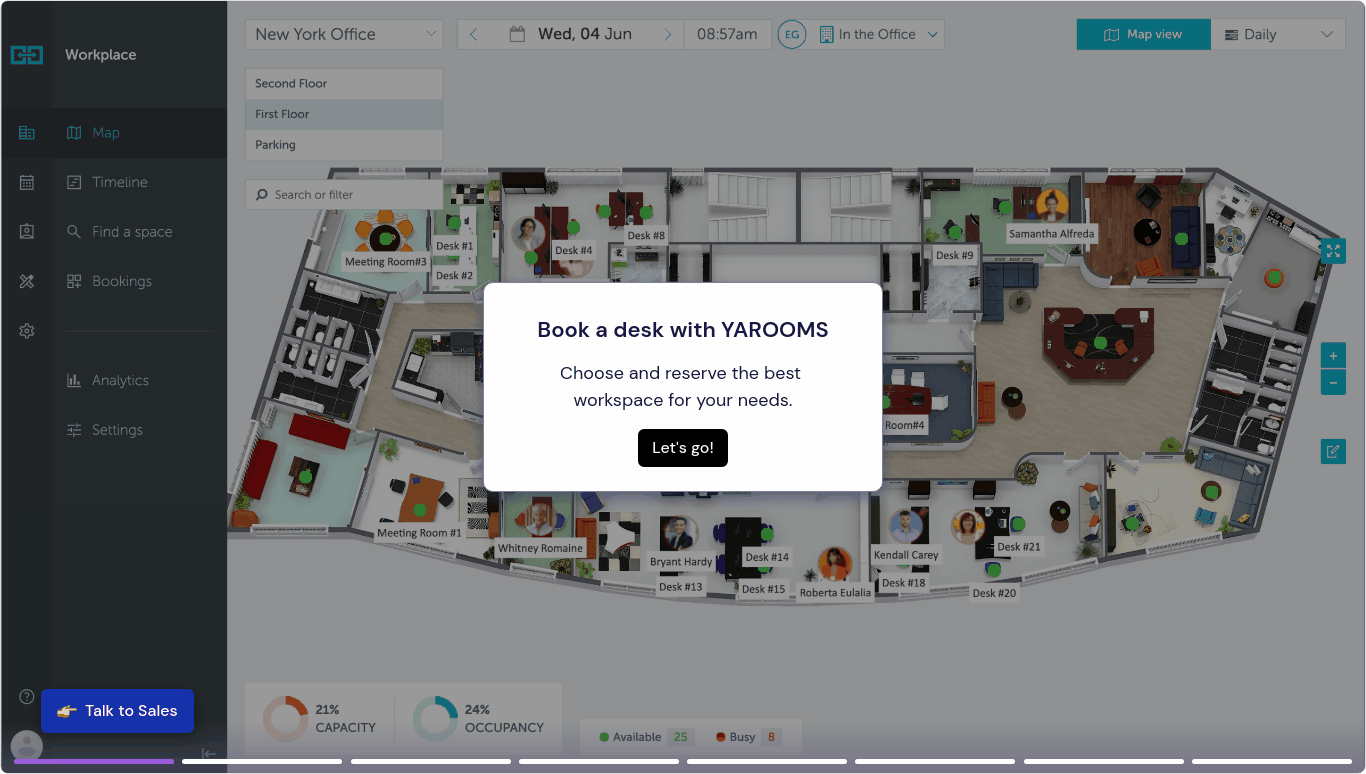A well-designed office seating arrangement can be the key to unlocking your team's full potential. It significantly impacts productivity, employee satisfaction, and overall office dynamics.
Discover how to create an optimal office layout that caters to various preferences by supporting collaboration while offering privacy when required. Let this definitive guide illuminate the path toward designing the perfect office seating arrangement for enhanced employee performance.
TL;DR:
- An optimal office seating arrangement is crucial for productivity, employee satisfaction, and office dynamics.
- Different types of seating arrangements include cubicles, open plan, bench seating, team tables, and flexible seating, each with its benefits and drawbacks.
- Well-designed seating arrangements offer advantages in ergonomics, collaboration, and privacy.
- Factors to consider when choosing a seating arrangement include office size, number of employees, company culture, and budget.
- Important considerations when choosing furniture include adjustability, quality, functionality, and storage.
- Flexibility is key in accommodating varying work styles and changes in the workplace.
- Common mistakes to avoid include neglecting ergonomics, lacking flexibility, and not considering privacy needs.
- Successful implementation involves clear communication, setting guidelines and expectations, and providing necessary support to employees.
Introduction to Office Seating Arrangement
The office seating arrangement is more than just a question of aesthetics; it is central to creating an efficient workspace where employees can thrive. A well-executed layout encourages cooperation and open communication, fostering easier knowledge sharing and more cohesive teamwork. On the other hand, failing to consider factors such as ergonomics, flexibility, and privacy may lead to decreased morale and hampered productivity.
In the contemporary business world, organizations continually seek ways to drive innovation while maintaining cost efficiency—making office layout planning increasingly crucial. Consequently, companies invest heavily in designing workspaces tailored to accommodate diverse work styles that promote employee satisfaction without sacrificing productivity.
This guide provides readers with insights into different types of office seating arrangements, their benefits, essential factors to consider when choosing one for their workspace, common mistakes to avoid during implementation, and best practices for maintaining an effective workplace environment from start to finish.
Types of Office Seating Arrangements
Cubicles
A traditional office seating arrangement still used by many organizations worldwide is the cubicle layout. Often considered a symbol of corporate life, cubicles provide each employee with their own private workspace surrounded by partitions. These spaces allow for increased focus and privacy while reducing noise and distractions. Some employees appreciate the personalization that they can bring to their own space.
However, cubicles have faced criticism over their potential to isolate employees and hinder communication. While this format may work well for some industries or job roles requiring high concentration levels, it might not be suitable for workplaces emphasizing collaboration and teamwork.
Open Plan
In recent years, a trend has been towards more open-plan office seating arrangements, where employees work in shared spaces without physical boundaries. The open plan was designed to break down hierarchies and encourage communication and collaboration among colleagues.
Benefits of the open plan seating arrangement include cost savings due to reduced construction costs and the ability to accommodate more employees in less space. However, a significant drawback of open-plan offices is the need for more privacy and increased noise pollution, which can negatively affect productivity.
Bench Seating
Bench seating arrangement involves placing multiple employees along long tables without dividing partitions or barriers between them. This configuration is congruent with startup culture – it encourages teamwork, and interactions among coworkers and maximizes space usage.
This type of office seating does have its drawbacks related primarily to privacy issues: conversations can be overheard easily by others sitting nearby, etc.
Team Tables
Team tables are round or rectangular central tables that accommodate an entire team of professionals working on a project, encouraging inter-team coordination & dialogue in one place. The perks associated with team tables include quicker problem-solving through open discussions among team members fostering synergy within groups.
However, constant communication can hamper individual focus; when one team member engages in discussions or asks questions, the other can get distracted. Therefore, this is an ideal office seating arrangement in office settings like advertising agencies and design studios where group projects are common.
Flexible Seating
Flexible seating is a modern method of allocating desks or spaces to teams instead of individuals for cost-effective space utilization. This encourages dynamic working environments accommodating various work styles, from collaboration zones to focus areas depending on project requirements.
Employees are granted partial ownership over their working environment, which boosts their morale and productivity. However, flexible seating arrangements may also cause disputes among coworkers.
To conclude, there is no one-size-fits-all approach when determining the most suitable office seating arrangement. A blend of workspace types might be more effective – tailoring the layout based on task relevance, employee preferences, and your organization's values. Consider your workforce's unique needs before deciding which type of office seating arrangement will best achieve a functional work environment.

Benefits of a Well-Designed Office Seating Arrangement
A well-designed office seating arrangement can significantly impact employee satisfaction, productivity, and overall workplace atmosphere. It is essential to carefully plan your office layout to ensure you reap the benefits it has to offer. This section will discuss three key advantages of an effective office seating arrangement: ergonomics, collaboration, and privacy.
Ergonomics
The first benefit of a well-planned office seating arrangement is improved ergonomics. Employees spend most of their working hours sitting at their desks; therefore, it's crucial to prioritize their comfort by providing adjustable chairs and sufficient legroom.
To enhance the ergonomic design in your office:
- Choose high-quality chairs with lumbar support
- Adjust desk height according to each individual's preference
- Ensure that monitors are positioned at eye level
- Encourage regular breaks for stretching and walking around
By focusing on ergonomics within your office seating arrangement, you will create a healthier work environment where employees can perform at their best.
Collaboration
Another significant advantage of an effective office seating arrangement is enhanced collaboration among team members. When seated close together within groups or departments, employees often find it easier to communicate and share ideas.
Here are some strategies for fostering collaboration through your office seating arrangements:
- Cluster desks together based on teams or shared projects
- Include communal spaces within the workspace for informal meetings or brainstorming sessions
- Offer easy access to whiteboards or digital display screens for visual collaboration
By promoting teamwork through thoughtful seating allocation, your organization can achieve more streamlined communication and foster innovative problem-solving skills.
Privacy
Finally, an essential aspect of any successful office seating arrangement is the balance between open space for collaboration and designated areas for privacy. While encouraging teamwork and communication is valuable, employees also need quiet personal spaces to concentrate on tasks without constant interruptions.
Consider these tips for providing privacy within your office seating arrangement:
- Incorporate designated quiet zones or private booths
- Use partitions or cubicles to create separation between workstations
- Provide noise-canceling headphones as an option for employees who prefer silence while working
Incorporating elements of privacy within your office layout will allow employees to focus better and show respect for their individual work preferences, ultimately supporting a more diverse range of work styles and productivity levels.

Factors to Consider When Choosing an Office Seating Arrangement
When it comes to designing the perfect office seating arrangement, multiple factors must be taken into account. The office layout significantly impacts employees' productivity, morale, and overall well-being. To make the best decision for your workspace, consider these crucial factors:
Office Size
One of the first aspects to assess is the size of your office:
- Evaluate the available space carefully and take accurate measurements
- Analyze any constraints or limitations that may affect how you can utilize the area effectively
- Look for opportunities within the space - such as by rearranging partitions or walls - to maximize its potential
In essence, making optimal use of every square foot is essential in creating a comfortable and efficient work environment.
Workflow and Communication Needs
Efficient communication is a driving force behind any successful team. Understanding how your team communicates will drastically influence your seating arrangements. If frequent face-to-face interactions are essential, consider grouping team members or opting for bench-style seating to encourage conversation. On the contrary, roles requiring deeper focus may thrive better in isolated areas or semi-private cubicles.
Number of Employees
Accommodating all employees comfortably while ensuring they have ample room to work is vital when planning an ideal office seating arrangement:
- Calculate the number of workstations needed based on your current employee count
- Ensure sufficient spacing between each workstation for ease of movement and accessibility
- Allow some room for future growth by factoring in potential new hires or team expansions
Providing enough personal space for each staff member contributes positively to their focus and productivity levels.
Company Culture
The company culture plays a crucial role in determining which type of office seating arrangement best suits your business:
- Collaborative Environment: If fostering collaboration is a priority, opt for open-plan layouts or team tables. This style encourages spontaneous discussions and idea-sharing between colleagues
- Privacy Focus: For companies where privacy is essential – such as legal firms dealing with sensitive cases – using cubicles provides employees with confidential spaces to work undisturbed
- Balanced Workplace: In many situations, incorporating flexible seating might offer the perfect balance between fostering teamwork while still allowing individuals time alone when needed
Continuously adapt your design solutions accordingly based on your company culture's immediate and long-term needs.
Budget
Financial constraints play a significant role in determining the ideal office seating arrangement for your workplace:
- Compare prices across various seating options, keeping durability and quality in mind
- Investigate cost-effective furniture choices that maintain ergonomics and comfort
- Allocate resources appropriately to ensure an optimized work environment without sacrificing aesthetic appeal
To obtain the best outcomes for employees and management, scrutinize budgetary factors while focusing on overall workplace productivity.
Employee Preferences
It's pivotal to remember that an office space should cater primarily to the people working in it—the employees. Incorporate their opinions when deciding upon arrangement styles because happy employees produce better results.
Gather feedback through surveys or personal conversations about their work habits, working styles, whether they prefer quiet spaces over interactive ones or which location might most effectively benefit their daily tasks.
Tips for Choosing the Right Office Seating Arrangement
Creating an office seating arrangement that meets your employees' diverse needs and preferences is challenging. This section discusses three crucial factors to remember when planning your workspace layout to ensure it aligns with your team's requirements and promotes a productive work environment.
Consider Your Employees’ Needs
As you contemplate various office seating arrangements, it's vital to prioritize the individual needs of each employee. Here are some essential aspects to consider:
- Ergonomics: Opt for chairs and desks that can be easily adjusted to provide maximum comfort and support
- Accessibility: Account for any accessibility requirements or accommodations needed by employees with disabilities
- Job responsibilities: Acknowledge how specific roles impact an employee's need for privacy or collaboration, then design spaces accordingly. For example, client-facing teams might require quieter areas
- Departmental interaction: Assess which teams frequently collaborate on projects and position them close together, enabling easy communication
By paying special attention to these factors, you will effectively address most concerns related to office desk arrangements and create a pleasant working environment tailored to your workforce.
Choose the Right Furniture
When selecting furniture for your office seating area, focus on aesthetics and practicality.
Here are several critical considerations while choosing furniture items:
- Adjustable: Chairs should have adjustable seat heights, armrests, lumbar support, and tilt mechanisms. Desks must allow height modifications if possible
- Quality materials: Durable and well-designed furnishings will last longer and lend a professional appearance to the workspace
- Functionality: Invest in functional pieces such as ergonomic keyboard trays or monitor arms that could contribute significantly towards employee welfare
- Storage: Providing reasonable storage solutions like drawers or cabinets is integral in helping keep workstations organized and clutter-free
Ultimately, opting for high-quality furniture that meets ergonomic standards will undoubtedly be a long-term investment in your employees' well-being.
Allow for Flexibility
A dynamic office seating arrangement should be adaptable to facilitate varying work styles, schedules, and unexpected changes.
To ensure flexibility within your workspace, consider implementing the following strategies:
- Modular or easily reconfigurable furniture: Having items like mobile desks with lockable casters, modular partitions, or wheeled chairs allow you to make changes quickly when needed
- Focus zones: Allocate designated areas for particular tasks or activities (e.g., brainstorming rooms, quiet corners) to help employees find an ideal location depending on their requirements
- Hoteling and hot-desking: Allowing employees to reserve unassigned workstations for specific durations can foster increased collaboration while also accommodating remote workers proficiently
- Incorporate remote working: Embrace hybrid work models where employees can choose between working remotely or at the office—this reduces the need for more seats and can increase employee satisfaction
Developing a flexible space allows you to experiment with various office seating arrangements and continually adapt and improve the working environment as organizational demands evolve.

Common Mistakes to Avoid When Choosing an Office Seating Arrangement
Creating the ideal office seating arrangement for your employees fosters productivity and ensures their comfort and well-being. However, this task can be challenging and requires careful consideration of various factors. Common mistakes must be avoided to achieve success in your workplace design.
Not Considering Ergonomics
Ergonomics plays a crucial role in promoting employees' physical health and comfort while working. Ignoring ergonomics when designing an office seating arrangement can lead to the following:
- Strain injuries
- Reduced productivity
- Low employee morale
- Frequent sick days
To avoid these issues, you should:
- Invest in ergonomic furniture that promotes proper posture and minimizes the risk of repetitive strain injuries
- Ensure adequate lighting to prevent eye strain
- Adjust monitor height and position to reduce neck strain
- Encourage employees to take breaks and stretch regularly
Considering ergonomics during the planning phase will create a more comfortable working environment that supports long-term employee wellness.
Not Allowing for Flexibility
A rigid office seating arrangement can hinder your team members' creativity, collaboration, and overall job satisfaction. Embracing flexibility in your office layout allows employees to choose suitable workspaces based on their tasks or preferences at any given time.
Here are some strategies for incorporating flexibility into your current or future office seating arrangements:
- Implement adjustable workstations that allow for standing or sitting options
- Offer quiet areas where employees can focus without distractions
- Designate communal spaces for teamwork activities or casual interactions
- Provide movable furniture to accommodate changing needs readily
Allowing employees to have some control over their workspace fosters a sense of autonomy, ultimately leading to improved performance and increased morale within the organization.
Not Considering Privacy Needs
Although fostering collaboration is essential in today's fast-paced business environment, providing privacy is equally crucial for employee well-being. A common mistake when planning office seating arrangements is to focus solely on team interaction while neglecting individual privacy needs.
To strike an optimal balance, consider the following approaches:
- Offer secluded spots or partitioned workstations for employees who require greater privacy.
- Utilize room dividers or screens to separate spaces without creating complete isolation.
- Use sound-absorbing materials in the design to minimize noise distractions throughout the office.
Integrating collaboration and privacy contributes to a more pleasant, effective working environment that suits the diverse preferences of your workforce. By avoiding these common mistakes during the planning process, you're more likely to achieve success in creating a productive and comfortable office seating arrangement.
How to Implement an Office Seating Arrangement Successfully?
To ensure your new office seating arrangement is effective and embraced by your employees, following a plan that incorporates clear communication, setting guidelines and expectations, and providing necessary training and support is essential.
Communicate with Your Employees
Open communication with your team members can significantly influence the success of implementing any change in the workplace. When creating a new office seating arrangement, consider these steps:
- Share the reasoning behind the changes – Make sure your staff understands the benefits associated with the new layout, be it improved ergonomics, increased collaboration, or privacy enhancement
- Involve them in the process – Request feedback and suggestions from all team members during the planning stage so they feel part of the decision-making process
- Use visual aids – Provide detailed office seating charts or floor plans to illustrate proposed alterations effectively
- Address concerns proactively – Encourage employees to voice any personal issues related to new arrangements; you can foster trust and buy-in by addressing these concerns early
Successfully introducing change relies upon transparency and inclusiveness; when people feel informed and involved from start to finish, they are more likely to accept adaptation positively.
Set Clear Guidelines and Expectations
Establishing a framework for achieving desired outcomes helps maintain harmonious environments resilient to change. To promote smooth transitions when introducing new office desk arrangements, follow these tips:
- Define protocols - Create guidelines on acceptable noise levels, appropriate use of shared spaces, and storage requirements for personal items within allocated spaces
- Establish boundaries - Delineate rules governing space restrictions (team tables vs. private desks) through signage or visual cues, as well as outlining mutual respect etiquette towards teammates’ workstations—their zone should never be invaded without permission
- 3. Elucidate meeting area usage - Offer guidance relating specifically to available meeting room bookings (notice periods/preferences), thus avoiding clashes/confusion
- Assign seating coordinators/managers - Appoint individuals responsible for overseeing fair seating allocation and addressing disagreements/discrepancies that may arise (especially if flexible seating is in place)
Provide Training and Support
Employee support mechanisms are crucial to embrace change positively and effectively. Here's how you can help your team transition smoothly into new office seating arrangements:
- Offer ergonomic training – As part of the shift, educate employees on optimizing their workstation setup; this might cover chair height adjustments, monitor placement, or utilizing footrests.
- Promote collaboration technology – Help build bridges between departments by providing technologies to foster casual communication
- Schedule regular check-ins – Openly seeking feedback from all staff levels post-change implementation helps gauge overall satisfaction levels/identify areas requiring further refinement or adjustment.
By maintaining open channels for dialogue, you can compel a more receptive mindset towards adaptation within your office space—ultimately establishing an environment that supports everyone's needs.
Best Practices for Maintaining a Good Office Seating Arrangement
Implementing the perfect office seating arrangement is only half the battle; maintaining it and ensuring it continues to provide benefits is equally important.
Keep the Layout Flexible
One of the primary rules for creating an effective office seating arrangement is to maintain flexibility. This means allowing employees to move around, switch seats when needed, or adjust their workstations over time. A few ways to achieve this flexibility include:
- Choosing furniture that's easy to move or reconfigure (e.g., modular desks, adjustable chairs)
- Providing designated spaces for temporary or collaborative work, such as "hot desks" or shared meeting rooms
- Regularly reassessing the office layout to accommodate changing team dynamics, new hires, or evolving project requirements
By fostering a dynamic office environment where employees can adjust their workspace depending on their needs, you promote adaptability and reduce frustration related to static or rigid seating arrangements.
Encourage Collaboration
Regardless of your chosen office seating arrangement type (cubicles, open plan, bench seating), there should always be opportunities for employees to collaborate effectively with one another. To promote communication and teamwork within your workplace:
- Group team members together who frequently need close communication, whether that's by department or job function
- Implement small breakout areas nearby workstations where colleagues can hold impromptu meetings without disturbing others
- Ensure communal spaces (such as conference rooms) are easily accessible from all parts of the office
Promoting collaboration can stimulate creativity among team members, foster better relationships with colleagues, boost morale, and improve overall company culture.
Provide Adequate Space
An essential aspect of any successful office seating arrangement is providing enough space for each employee while maximizing the available area. Overcrowded workspaces can lead to tension and decreased productivity, so finding a balance between space efficiency and employee comfort is critical.
When arranging office seating, take these factors into account:
- Ensure each workstation has adequate desk space for employees to spread out their work materials and electronic equipment (e.g., computers, keyboards, tablets)
- Provide enough breathing room between workstations to reduce distractions and prevent employees from feeling cramped or stressed
- Include ample storage solutions in your office layout to help employees stay organized and avoid cluttering up their workspace
With careful planning and adherence to these best practices, you'll be well on your way to fostering a comfortable, dynamic environment where employees are set up for success.
Regular Evaluation and Adjustment
No matter how meticulously planned your office seating arrangement is, it's not a set-it-and-forget-it solution. Just as businesses evolve, so should their office layout to maximize potential and improve employee collaboration.
The Benefits of Ongoing Evaluation and Adjustment of Seating Arrangement
Regular evaluation and adjustment of the seating arrangement can offer unexpected benefits.
- Enhanced Collaboration: Periodically changing seating arrangements can lead to employees working closely with different colleagues over time, promoting better interdepartmental relationships.
- Increased Employee Morale: Allowing employees to influence their workspace increases satisfaction and productivity.
- Reveal Insights into Communication Pathways: By evaluating the interaction patterns during various seating adjustments, you might uncover more efficient or innovative communication pathways within your team.
- Prevent Stagnation: Keeping things fresh by periodically reconsidering where people sit can prevent routines from turning into ruts.
It's also noteworthy that continuous assessments help you pinpoint any problems before they escalate into major issues that significantly disrupt workflow.

Steps to Conduct Periodic Assessment and Improvement
Organizing regular assessments followed by well-thought-out modifications may sound tricky, but here's a simple step-by-step approach:
- Establish Assessment Interval: Decide how frequently you'll conduct seating performance evaluations. Many industries choose every quarter.
- Observe & Listen Actively: Watch for changes in communication patterns, workflow efficiency, and employee behavior while listening out for feedback about the current arrangement.
- Survey Employees: Anonymous surveys are a great way to get honest feedback from staff regarding their satisfaction level with existing spatial arrangements.
- Analyze Data: Use all collected data — observational notes, survey results, etc.- to make an informed decision about whether or not an adjustment may be beneficial. Look for patterns, common issues, or complaints.
- Propose & Implement Adjustments: Based on analysis, propose solutions; it could be as minimal as moving one team closer to another or a complete overhaul of the office layout. Once decided, implement changes in a phased manner.
Remember, an office seating plan isn't about chasing the latest trends but creating a collaborative and productive environment where your team can excel. Your goal is to find the 'sweet spots' that improve communication flow while keeping employee morale high, thereby enhancing overall organizational performance.
Does Anyone Actually Prefer 'Open Office' Space?
The concept of an 'open office' space has been a topic of heated debate among professionals from various disciplines. Some ask whether employees prefer an open layout instead of other traditional office structures, like cubicles or private offices.
A survey conducted by Gensler showed that 72% of staff working in successful businesses preferred open environments. They cited collaboration and knowledge sharing as critical reasons for their preference, highlighting the power this type of workspace could have when incorporated correctly. Breaking down visible barriers encourages accessible communication and allows for spontaneous idea generation.
However, tempering these positives with the challenges stemming from such layouts is essential. Noise disturbances and lower privacy exist, often leading to stacked opinions towards open office spaces. These issues, nevertheless, can be mitigated through careful planning and effective utilization of diverse seating strategies.
In short, while not everyone may welcome the shift toward an open office environment with open arms, a substantial number certainly recognize its collaborative benefits. With thoughtful design measures in place—ones that balance openness with quiet zones for concentrated work—it is possible to create a well-received open-concept workspace that employees appreciate.













